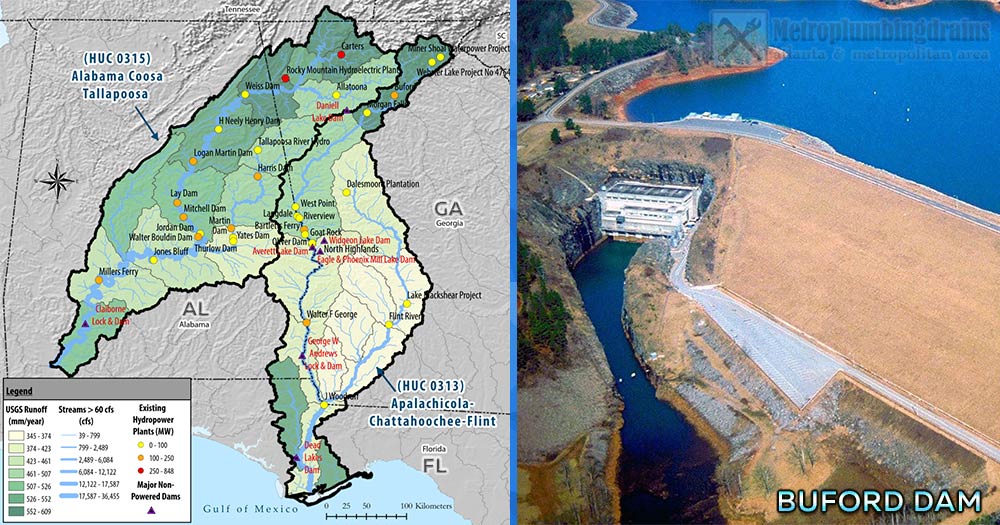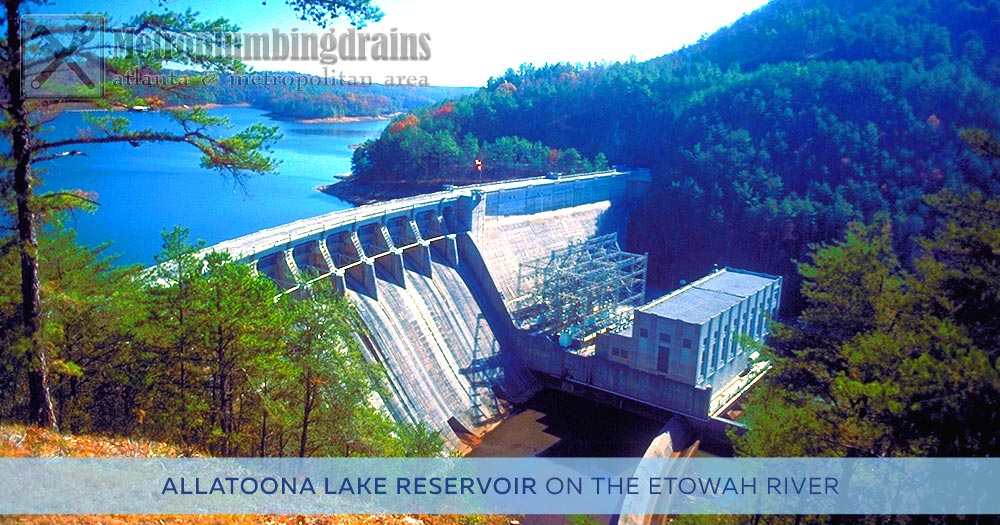Atlanta and the Metro Area Stats
The population of the Atlanta Metropolitan Area in 2021 was 6.1 million. About 50 different water sources cover their daily household and industrial needs. There are nearly 161,000 commercial and residential water account owners in Atlanta City. Atlanta’s Department of Watershed Management employs more than 1,500. The City also has 12 water storage tanks with a capacity of 37 million gallons.
What are the largest water resources for Atlanta and the Metropolitan Area?
Lake Lanier covers about 70% of the region’s needs. It is an artificial lake that was created in 1950 when Buford Dam dammed the Chattahoochee River. The other major source is Lake Allatoona (20%). Only 1% of Atlanta’s water is provided by underground sources because it is nearly impossible (and very expensive) to drill for wells through the thick granite bedrock on which the city and surrounding area are situated. Therefore, in addition to the two large lakes, the population of Atlanta and the Metropolitan area relies on 20 other large water reservoirs.
The Three-State Water War
The legal “water wars” between the states of Georgia, Alabama, and Florida started in the early 1990s as a result of Atlanta’s inability to utilise subsurface water sources and having to rely solely on surface water. It was fought over the right to use water from two shared river basins: the Apalachicola-Chattahoochee-Flint, and the Alabama-Coosa-Tallapoosa.
Both major water basins, Lanier and Allatoona, are managed by the U.S. Army Corps of Engineers. The State of Alabama began the “Tri-State Water Wars” with its lawsuit asking the U.S. Army Corps of Engineers to discontinue additional water deliveries from the two lakes to Atlanta and the surrounding area.
In 2014, the State of Florida filed a lawsuit in court against the State of Georgia. Florida wanted to limit Georgia’s use of Apalachicola-Chattahoochee-Flint waters to 1992 levels of consumption. In 2021, the Supreme Court rejected Florida’s claim and ruled in favor of Georgia.
The court battle of Cobb County, Marietta, and the State of Georgia Water Authority v. Army Corps
In 2015, the U.S. Army Corps of Engineers made changes to water use on the Alabama-Coosa-Tallapoosa basin. Atlanta Metro’s request to reconsider their need for additional water supply for domestic and industrial uses was denied.
Cobb County, Marietta and the State of Georgia Water Authority begin a court battle with the Corps of Engineers. And Army Corps was found to have violated the law by failing to meet Metro Atlanta’s water supply needs and was instructed by the court to make a definitive decision about water supply needs from Allatoona Lake by August 2021.
Following the conclusion of a full Environmental Impact Statement and a three-year “Reallocation Study,” the Corps of Engineers on August 30, 2021, signed a Record of Decision approving Metro Atlanta’s water supply demands from Allatoona Lake. The verdict confirms that Atlanta Metro’s anticipated 2050 water supply needs from Allatoona Lake of 94 million gallons per day will be satisfied.
Wastewater management: Atlanta and the surrounding area
The Atlanta Metropolitan Area sewer infrastructure has a capacity of approximately 700 million gallons per day. About 10% of the metro area’s dirty water is collected in septic pits.
The sewer system of Atlanta and surrounding communities is among the most developed in the country. The 11-stage treatment process at the F Wayne Hill Water Resource Plant in Gwinnett completely closes the water loop. The facility cleans dirty water and returns it fully purified to Lake Lanier. The wastewater treatment facility in Gwinnett is among the best in the world.
The water treatment method known as “wetlands” is practices by water authorities in Clayton County. This method of water management in Clayton County has been the subject of considerable scientific study because of its resilience and eco-friendly nature. In 2007, Atlanta and the state of Georgia experienced the worst drought in its history. However, the “wetlands” method managed to keep the Clayton Reservoir at 75-80% of its capacity.
Sewer systems with the largest wastewater treatment capacity in the Atlanta Metro Area:
- Fulton County – 256 mln g/day.
- Cobb County – 112 mln g/day.
Coweta County comes in last with 7 mln g/day.
Metroplumbingdrains employs the best sewer system specialists in Georgia
If your sewer system is faulty and you need a professional sewer plumber, this is the number to call: 470 435-4377.
You can also request a plumber visit your home or office from here:


